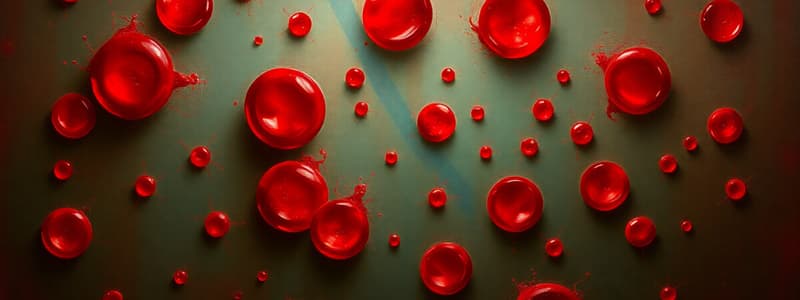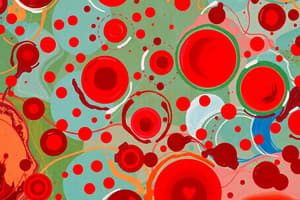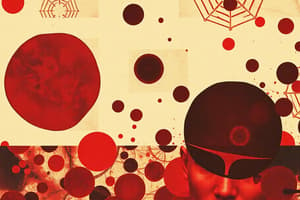Podcast
Questions and Answers
Match the blood component with its primary function:
Match the blood component with its primary function:
Red blood cells = Oxygen transport White blood cells = Immune response Platelets = Blood clotting Plasma = Transport medium
Match the type of leukocyte with its function:
Match the type of leukocyte with its function:
Neutrophils = Phagocytosis of bacteria Lymphocytes = Antibody production Monocytes = Development into macrophages Eosinophils = Defense against parasites
Match the plasma protein with its function:
Match the plasma protein with its function:
Albumin = Osmotic pressure regulation Immunoglobulins = Antibody function Fibrinogen = Blood clotting Globulins = Transport of lipids
Match the blood type with its compatibility as a donor:
Match the blood type with its compatibility as a donor:
Match the blood disorder with its description:
Match the blood disorder with its description:
Match the following terms with their descriptions related to blood:
Match the following terms with their descriptions related to blood:
Match the property with the responsible blood component:
Match the property with the responsible blood component:
Match these characteristics with the correct blood cell type:
Match these characteristics with the correct blood cell type:
Match the function to the part of the blood responsible.
Match the function to the part of the blood responsible.
Match each component found in blood plasma with its main role:
Match each component found in blood plasma with its main role:
Match cell function to its description:
Match cell function to its description:
Identify the role of each cell fragment in blood:
Identify the role of each cell fragment in blood:
Categorize the following ABO blood groups with their blood compatibility:
Categorize the following ABO blood groups with their blood compatibility:
Match the descriptions with their corresponding blood-related conditions:
Match the descriptions with their corresponding blood-related conditions:
Match these terms with their association to blood formation or problems:
Match these terms with their association to blood formation or problems:
Match the blood components with their main components
Match the blood components with their main components
Match the purpose with its type of white blood cell
Match the purpose with its type of white blood cell
Match the terms with the description of function
Match the terms with the description of function
Match the proteins with their function in blood plasma.
Match the proteins with their function in blood plasma.
Match each symptom with the corresponding blood or bone disease:
Match each symptom with the corresponding blood or bone disease:
Flashcards
What is blood?
What is blood?
Bodily fluid in animals delivering nutrients/oxygen to cells and transporting waste away.
What is the composition of vertebrate blood?
What is the composition of vertebrate blood?
Blood cells suspended in blood plasma; includes red blood cells, white blood cells, and platelets.
What are the primary functions of blood?
What are the primary functions of blood?
Supplies oxygen/nutrients, removes waste, immune functions, coagulation, messenger functions, and regulates pH.
What are key plasma proteins?
What are key plasma proteins?
Signup and view all the flashcards
What is the function of red blood cells (erythrocytes)?
What is the function of red blood cells (erythrocytes)?
Signup and view all the flashcards
What is hemoglobin?
What is hemoglobin?
Signup and view all the flashcards
What is the purpose of the biconcave disc shape of erythrocytes?
What is the purpose of the biconcave disc shape of erythrocytes?
Signup and view all the flashcards
What is the function of leukocytes?
What is the function of leukocytes?
Signup and view all the flashcards
What is the function of neutrophils?
What is the function of neutrophils?
Signup and view all the flashcards
Name the three types of lymphocytes and their functions.
Name the three types of lymphocytes and their functions.
Signup and view all the flashcards
What is the role of monocytes?
What is the role of monocytes?
Signup and view all the flashcards
What is the function of eosinophils?
What is the function of eosinophils?
Signup and view all the flashcards
What is the function of basophils?
What is the function of basophils?
Signup and view all the flashcards
What are platelets (thrombocytes)?
What are platelets (thrombocytes)?
Signup and view all the flashcards
What do platelets do when blood vessel damage occurs?
What do platelets do when blood vessel damage occurs?
Signup and view all the flashcards
The ABO blood group system
The ABO blood group system
Signup and view all the flashcards
What is the Rh blood group system?
What is the Rh blood group system?
Signup and view all the flashcards
What is the 'universal donor' blood type?
What is the 'universal donor' blood type?
Signup and view all the flashcards
What is hematopoiesis?
What is hematopoiesis?
Signup and view all the flashcards
What is anemia?
What is anemia?
Signup and view all the flashcards
Study Notes
- Blood is a specialized bodily fluid in animals that delivers necessary substances such as nutrients and oxygen to the cells and transports metabolic waste products away from those same cells.
- In vertebrates, blood is composed of blood cells suspended in blood plasma.
- Plasma, which constitutes 55% of blood fluid, is mostly water (92% by volume) and contains dissolved proteins, glucose, mineral ions, hormones, carbon dioxide, and blood cells.
- The blood cells are mainly red blood cells (also called erythrocytes), white blood cells (also called leukocytes), and platelets (also called thrombocytes).
- Blood performs many important functions, including:
- Supplying oxygen to tissues
- Supplying nutrients such as glucose, amino acids, and fatty acids
- Removing waste products such as carbon dioxide, urea, and lactic acid
- Immunological functions, including circulation of white blood cells, and detection of foreign material by antibodies
- Coagulation, which is one part of the body's self-repair mechanisms
- Messenger functions, including transport of hormones and signaling of tissue damage
- Regulation of body pH
Blood Components
- Blood consists of plasma and several kinds of cells.
- Plasma is the liquid component of blood, in which the blood cells are suspended and constitutes about 55% of blood volume.
- Plasma is about 92% water, 7% proteins, and 1% electrolytes, nutrients, and waste.
- Key plasma proteins include:
- Albumin: Regulates osmotic pressure and transports lipids, hormones, and calcium.
- Immunoglobulins: Antibodies released by plasma cells during immune response.
- Fibrinogen: Essential for blood clotting.
- The cellular components of blood are:
- Red blood cells (erythrocytes)
- White blood cells (leukocytes)
- Platelets (thrombocytes)
Red Blood Cells (Erythrocytes)
- Red blood cells are the most abundant cells in the blood, responsible for transporting oxygen from the lungs to the body tissues and carbon dioxide from the tissues back to the lungs.
- Erythrocytes contain hemoglobin, an iron-containing protein that binds to oxygen.
- Mature red blood cells are anucleate (lack a nucleus) in mammals, maximizing space for hemoglobin.
- Erythrocytes have a biconcave disc shape, which increases their surface area for gas exchange and allows them to squeeze through narrow capillaries.
- The lifespan of a red blood cell is approximately 120 days.
White Blood Cells (Leukocytes)
- White blood cells are involved in the immune response, protecting the body against infection and foreign invaders.
- Leukocytes are nucleated and can move independently, allowing them to migrate to sites of infection or inflammation.
- There are several types of leukocytes, each with a specific function:
- Neutrophils: Phagocytic cells that engulf and destroy bacteria and fungi and are the most abundant type of leukocyte.
- Lymphocytes: Include B cells (produce antibodies), T cells (kill infected cells and regulate immune responses), and natural killer (NK) cells (attack and kill abnormal cells).
- Monocytes: Differentiate into macrophages, which are phagocytic cells that engulf pathogens, cellular debris, and foreign substances.
- Eosinophils: Involved in allergic reactions and defense against parasitic infections.
- Basophils: Release histamine and other mediators of inflammation.
Platelets (Thrombocytes)
- Platelets are small, anucleate cell fragments derived from megakaryocytes in the bone marrow.
- Thrombocytes play a critical role in blood clotting (hemostasis), preventing excessive bleeding after injury.
- When blood vessel damage occurs, platelets adhere to the damaged site, aggregate, and form a platelet plug and also release factors that activate the coagulation cascade, leading to the formation of a fibrin clot.
Blood Groups and Transfusions
- Human blood is classified into different blood groups based on the presence or absence of specific antigens on the surface of red blood cells.
- The ABO blood group system is based on the presence or absence of A and B antigens, where individuals can be type A, type B, type AB, or type O.
- The Rh blood group system is based on the presence or absence of the Rh D antigen, where Individuals are either Rh-positive (Rh+) or Rh-negative (Rh-).
- Blood transfusions must be compatible between the donor and recipient to avoid a transfusion reaction, where the recipient's immune system attacks the donor's red blood cells.
- Type O-negative blood is considered the "universal donor" because it lacks A, B, and Rh antigens and can be transfused to individuals of any ABO and Rh blood type in emergencies.
- Type AB-positive blood is considered the "universal recipient" because individuals with this blood type can receive red blood cells from any ABO and Rh blood type.
Hematopoiesis
- Hematopoiesis is the process of blood cell formation, which occurs in the bone marrow.
- All blood cells originate from hematopoietic stem cells, which are pluripotent cells capable of differentiating into any type of blood cell.
- Hematopoiesis is regulated by various growth factors and cytokines, which stimulate the proliferation and differentiation of blood cell precursors.
Blood Disorders
- Anemia: A condition characterized by a deficiency of red blood cells or hemoglobin, resulting in reduced oxygen-carrying capacity of the blood and can be caused by iron deficiency, blood loss, genetic disorders, or chronic diseases.
- Leukemia: A type of cancer of the blood or bone marrow characterized by the abnormal proliferation of white blood cells.
- Thrombocytopenia: A condition characterized by a deficiency of platelets, leading to an increased risk of bleeding.
- Hemophilia: A genetic disorder characterized by a deficiency of certain clotting factors, resulting in impaired blood clotting and excessive bleeding.
- Blood clots: Can form in veins (deep vein thrombosis, DVT) or arteries (arterial thrombosis), obstructing blood flow and potentially leading to serious complications such as pulmonary embolism or stroke.
Studying That Suits You
Use AI to generate personalized quizzes and flashcards to suit your learning preferences.




